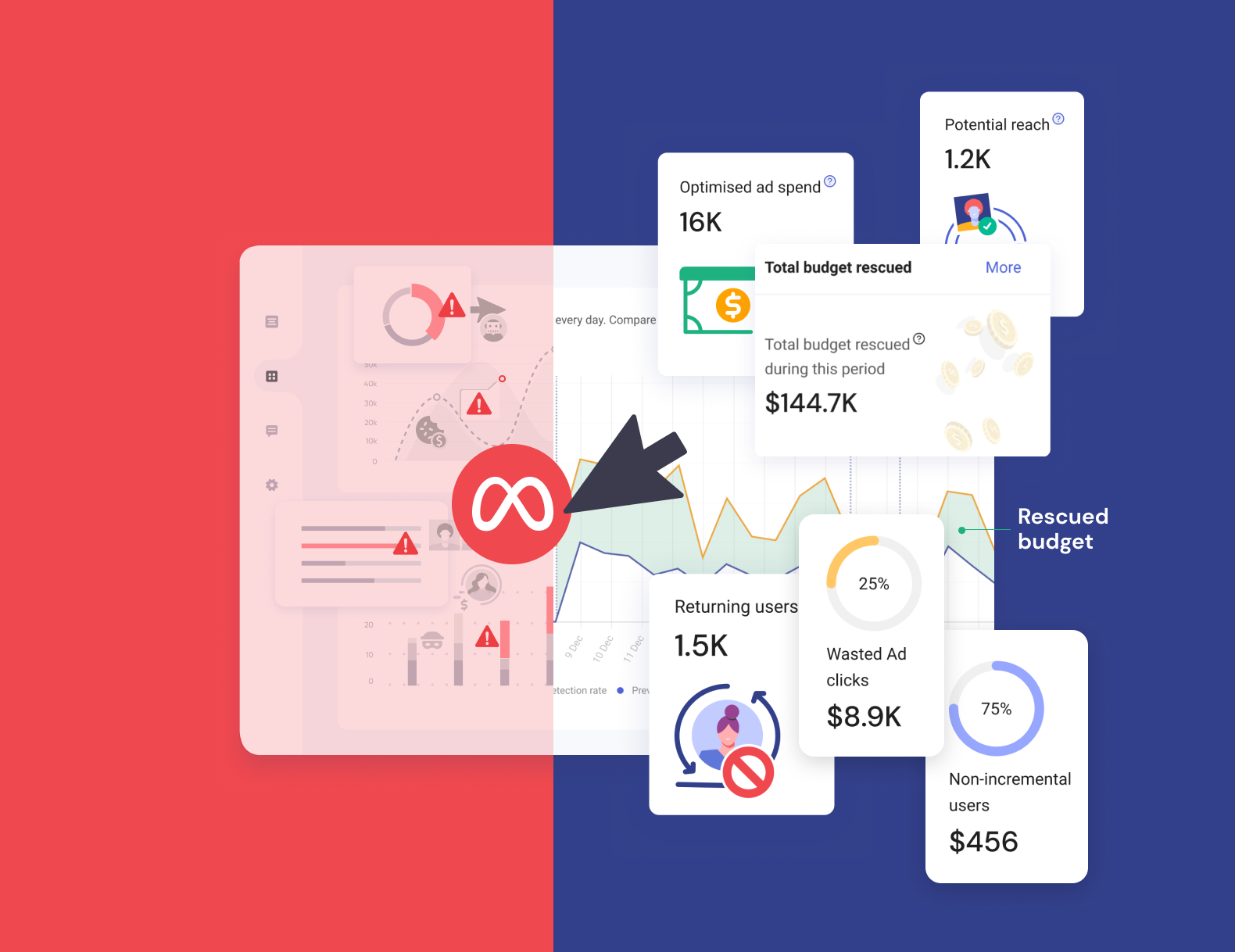How Ad Fraud Impacts Marketing KPIs

Digital ad fraud is now a 100 billion US dollar drag on business success, nearly tripling in the last five years. As the convenience and relatively low cost of digital advertising have grown, so have the numbers of bad actors, with more than a quarter of web traffic made up of negative bot activity. Clearly, ad fraud – whether bot or not – will impact your bottom line in terms of both return on ad spend (ROAS) and customer acquisition cost (CAC), which should be as high as possible and as low as possible respectively. A less obvious problem is that it lays false trails meaning that not only is your current campaign less effective than it should be, the bad data collected from it could potentially negatively impact your future campaigns as well. Our use here of CAC as opposed to the more common Cost Per Acquisition is a deliberate one; CAC measures the cost of acquiring a paying customer as opposed to simply a lead as is the case with CPA.
With 94 per cent of consumers researching products online before buying and three in five using search engines as digital shopping malls, small businesses can see up to 80 per cent of their business coming from digital advertising, meaning ad fraud could mean the difference between success and failure. (Google, The Small Business Online Marketing Guide)
That isn’t to say that all invalid traffic, that is to say engagement that isn’t out of genuine interest in the advertised product is malicious and deliberate ad fraud; we have all clicked on ads by mistake or accident but whatever the cause, the result is zero ROAS. A robust way to detect and tackle invalid traffic of all types is the best solution.
In this article, we'll explore how ad fraud impacts these key marketing KPIs in different areas like Pay Per Click (PPC), mobile, affiliate, and social, and discuss what you can do to protect your business from it.
One-fifth of your clicks could be fake
Digital ad spending rocketed in 2021 as the world got to grips with the Covid-19 pandemic and began to see a way out the other side. According to eMarketer there was a 29.1% increase YoY to $491.7 billion US dollars in 2021 and the company predicts the total to exceed half a trillion dollars in 2022. Much of that will be driven by PPC as one of the most accessible, targeted and cost effective forms of digital advertising, particularly for small to medium enterprises (SMEs) a category which accounts for 90 per cent of the world’s businesses, employing more than half the total workforce. (https://www.worldbank.org/en/topic/smefinance). If the size of the industry is now staggering, so is the potential amount lost; Juniper Research estimates US$51 million per day in 2021, rising to US$100 million in 2023.
And the problem is by no means confined to smaller businesses with less sophisticated digital advertising strategies. Enterprise-level companies with highly experienced marketing teams experience click fraud on a similar scale and, given the larger budgets involved, the sums lost to scammers can be eye watering. A sports betting client we acquired in 2021 was found to be losing 20.8 per cent of its Google ads budget to invalid traffic, ascertained during our Detection Audit offering. Once our Prevention measures - which automatically remove invalid traffic - were put in place, this dropped to 1.4 per cent returning A$779,132 to our client’s budget in 2022.
Click fraud is one of the most common forms of ad fraud enacted against PPC campaigns through the use of bots, clicks farms or false websites and, as well as decreasing ROAS and increasing CAC whilst leading to a false sense of success through an inflated number of clicks.
Combating this can feel like it takes more time than creating the ad campaigns themselves, with marketing teams forced to manually review and filter IP addresses and constantly look for anomalies or patterns that indicate fraud may be taking place – an unusual spike in CAC without any corresponding increase in ROAS.
$75bn wasted on mobile ads in the APAC region
Do you remember the days before you had a smartphone? No? Us neither. It is unsurprising then that the addictive device almost all of us not just carry in our pockets but are generally glued to throughout the day is the primary target for advertisers. In fact, of the half trillion digital ad spend in 2022, well over half (57 per cent) will be spent on mobile, up 17.1 per cent on 2021.
And since most of us put a lot of trust into our rectangular silicon companions, it is hardly surprising that mobile advertising is increasingly a target for fraudsters using ever more sophisticated methods, many of which are almost as sophisticated as the devices they are acting upon. An investigation carried out on our behalf by Juniper Research found that the three top categories of mobile ad fraud are: app install farms/SDK spoofing at 42 per cent followed by click injection at around 30 per cent and then click spam and ad stacking at 27.3 per cent. The APAC region is particularly badly affected with an estimated $75 billion lost in this way in 2022.
The methods used can be divided into a few broad categories:
- CPM fraud
- CPC fraud
- CPI fraud
- Fraudulent traffic
- Misattribution
Cost per Mille (CPM) fraud includes ad stacking where multiple ads are layered atop one another and the user only sees the top ad but all the advertisers in the stack are charged; invisible pixels where ads are loaded into a single pixel invisible to the user and unstoppable ads and autoplay videos which are always loading and playing in the background of apps that may not even be being used.
Cost per Click (CPC) fraud uses automatic redirects to send users to ad landing pages and can falsely attribute conversion while straight up deception is common through the use of unrelated landing pages and fake close buttons.
Cost per Impression (CPI) fraud includes the creation of false installs by faking smartphone information or cracking the software development kit (SDK) or even the use of a click farm where apps are manually installed on multiple devices. Mobile emulator software takes this one step further by creating thousands of virtual smartphones to install apps and run ads continuously.
Fraudulent traffic is perhaps the easiest to comprehend with fraudsters taking actions as simple as providing fake data on geolocation or audience targeting to give the impression that the audience paid for is indeed the one reached. Other methods include spoofing to make one smartphone look like dozens and of course the ever-present bots proving fake clicks, installs and even falsifying entire user profiles.
Misattribution is perhaps one of the most frustrating to marketers as ad engagements such as clicks and app installs are deliberately or inadvertently assigned to the wrong source. As well as negating your ROAS, this skews results so that decisions made when scaling a campaign can only increase the problem and loss of investment. Ensuring that only valid traffic is allowed through to the attribution stage protects your budget and allows investment with the relevant partners.
Not so trusted partners
Affiliate marketing may predate the internet by decades but it does attract a significant amount of spend, with around $ 8 billion assigned to it in the US alone. The attractions are obvious, it is as close as digital advertising gets to word of mouth or personal recommendations that carry so much trust and power. That trust is also the foundation of many affiliate programs; you want to feel your brand is being placed in the hands of people you believe will represent and promote it well in return for a slice of your marketing budget. This unfortunately is where the difference between other instances of ad fraud may lie since the affiliate themselves may be the ones perpetrating ad fraud in order to increase their own earnings rather than it being the actions of an anonymous click farmer in a far-flung country.
The types of affiliate marketing fraud can be roughly divided into two categories; firstly where the affiliate is acting fraudulently towards their partner which could include not providing sub partner data for reconciliation and secondly where they are defrauding their audience. Examples of the first include generating fake clicks on affiliate links that have no potential to increase sales; or cookie stuffing and unauthorised redirects which steal referrals from other affiliates. The second category includes actions such as deliberately concealing paid promotions using URL redirects or simply spamming users with unsolicited communication and promotions.
Social media spoofing
There are billions of social media users around the world. And billions of them are fake accounts, created to farm data and create fake clicks. Facebook alone clears out 1.5 billion fake accounts every quarter and the vexed question of bots was what originally derailed Elon Musk’s takeover of Twitter. Spending on social media continues to increase with Facebook and Instagram taking in $58 billion in the US alone in 2022. The previous year Instagram overtook its parent company in terms of total US ad revenue and in 2023 is predicted to account for 60 per cent of the takings.
Clearly the fraudsters will follow the money, which is why social media is a breeding ground for traffic fraud, essentially views by non-human users, or bots. The ANA/White Ops Bot Baseline 2016-2017 Report estimated that a quarter of video views come from robots rather than humans. Speaking of humans, they too are part of the problem through click farms where groups of workers in emerging market countries are paid miniscule amounts to repeatedly click on social media ads to generate false impressions.
Help is at hand
Digital advertising is one of the most effective ways to reach your target audience at all the various stages of your marketing funnel from awareness to acquisition. That, and its ease of use and access is why it is now a business worth more than half a trillion dollars globally. But that is exactly what makes it such a tempting target for fraudsters and the victims aren’t just the big global corporations but millions of SMEs across the world using the various tools available to them to strive for success.
It can seem too daunting a prospect to take the plunge or perhaps you have already been targeted by one of the bad actors out there. We are here to help. TrafficGuard offers solutions to keep you, your marketing budgets and your business safe in the digital advertising world. We can align with your existing systems and processes to add the extra layer of analytics, security and expertise to ensure your ROAS is high and your CAC low.
Get started - it's free
You can set up a TrafficGuard account in minutes, so we’ll be protecting your campaigns before you can say ‘sky-high ROI’.
Subscribe
Subscribe now to get all the latest news and insights on digital advertising, machine learning and ad fraud.








